As a marketer, you believe in what you’re doing, but it’s difficult to measure results, so how can you measure marketing ROI?
When your company engages in many activities to improve results, it can be difficult to prove the effectiveness of some activities. That’s where marketing ROI comes in.
Sure, you can spell out some figures like likes and shares, but how much did these metrics contribute to your company’s bottom line? If you can’t connect these activities to tangible returns, then there’ll be little justification in engaging in those tasks.
As a marketer, you believe in what you’re doing, but it’s difficult to measure results. Even more, you might be unable to claim the positive results if your company has invested in other strategies.
Take content marketing as an example. Even though 91% of B2B organizations invest in content marketing, only 35% of them measure its ROI. Among those who fail to measure, 27% claim it’s because “We don’t know how to do this.”
Campaigns like brand awareness or influencer marketing are difficult to measure. How do you define success? How do you know your company has gained more than they’ve spent on the campaign?
Since you can’t accurately measure your results, it’s difficult to prove ROI. But you can still prove that your efforts are bringing results to the business.
In this blog post, discover how to prove ROI when you can’t accurately measure results.
Define your strategy
Before you can get results, you need to have a strategy for your marketing efforts. Without a strategy in place, it’s difficult to convince a third party of how effective your campaign will be.
In some cases, a past campaign might have informed your strategy. If a campaign achieved some results that you’d like to replicate for your business, then you can study this campaign process and adopt a part of it into your own strategy.
A Smart Insights survey reveals that 45% of organizations have no defined strategy for their digital marketing efforts. It can be difficult to prove ROI in cases like these.
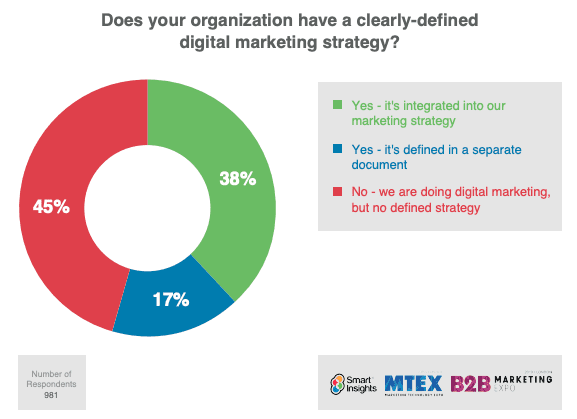
It is important that your campaign strategy is stated clearly. Even though there might be slight changes during execution, you should be able to explain your strategy to other people.
Your campaign strategy should contain:
- You campaign plan
- How you’ll execute the plan
- The possible cost
- Possible results
- Value of your results
- Similar campaigns in the past and their results
If it’s difficult to measure your campaign results, then a solid strategy can state clearly all the possible benefits your business can gain from this campaign. This way, you’re able to convert these benefits into monetary value for your business.
Likewise, referring to past similar campaigns and their results can convince others that you can achieve similar results.
Define your goals
To prove the ROI of a marketing campaign, you need to have goals you want to achieve by the end of the campaign. Having specific goals helps you to determine the failure and success of your campaign.
Some possible goals you might target for these campaigns are:
- Website traffic
- Social media engagement (likes, comments, and shares)
- Social media account growth (more followers)
When you define these goals, the first way your campaign is judged will be based on the achievement of these goals. If your goal is to bring in 2,000 referral traffic from a brand awareness campaign, then the first step to proving ROI is to achieve that goal.
Looking for marketing strategy advice?
Set a vision for your work, and demonstrate that your marketing activities are adding value. But, how can you be sure you’ve chosen the right KPIs, or that your long-term plan will deliver?
If you’re looking for quick, actionable marketing strategy tools, the RACE Framework offers you a quick at-a-glance overview of your marketing strategy, and how your channels and touchpoints are performing within the customer lifecycle.
Our acclaimed marketing funnel plan empowers marketers to track their customers’ experiences of their brand across reach, act, convert, and engage, to identify and prioritize high-performing customer journeys. What’s more, by tracking your marketing activities through the funnel you can attribute and prove your ROI.
Book a free 1-2-1 consultation call with a member of our customer team to discuss your marketing strategy in the context of the RACE Framework. In your consultation, you can discuss challenges and identify opportunities to optimize your marketing funnel. Find marketing solutions that work for your business and get advice on your next steps. Book your call to get started today.
Link your results to marketing ROI
After achieving your goals for a campaign, the next step is to calculate the value of your results in revenue to your company. For example, if your goal is to generate 2,000 more visits to your website, you need to calculate how much a visit is worth.
You can use your website’s historical data to calculate this. How many leads does your website gain from 1,000 visitors? How many of them become customers? What is the average customer lifetime value (CLV) of your customer?
With these numbers, you can calculate what a single visit is worth to your website. Let’s consider an example. If your company gain 50 leads from 1,000 visitors, it means you have a visitor-to-lead conversion rate of 5%.
If out of 50 leads, you turn five of them into customers, then it means you have a lead-to-customer conversion rate of 10%. Let’s say the average customer lifetime value (CLV) is $500.
From these values, you can get an estimate of what a website visit is worth. In this case, a lead is worth $500 × 10% which is $50. A visit is worth $50 × 5% which is $2.5.
For social media metrics like reach, the number of likes, comments, and shares, it can be more difficult to measure. For your business, you can calculate the estimated value of these metrics. There are also tools that help with this.
Let’s consider some common marketing campaigns and how to determine their ROI.
Marketing ROI of brand awareness activities
When a potential customer is looking to buy a product, who do you think they’ll buy from? A brand they already know or a strange one?
That’s why brand awareness is vital to any business. But how do you calculate the value of a specific brand awareness campaign? This is where it gets a little bit complicated.
Some results you can get from a brand awareness campaign are:
- Website traffic
- Earned media
- Backlinks
- Blog shares
- Social engagement
- Organic traffic from brand search terms
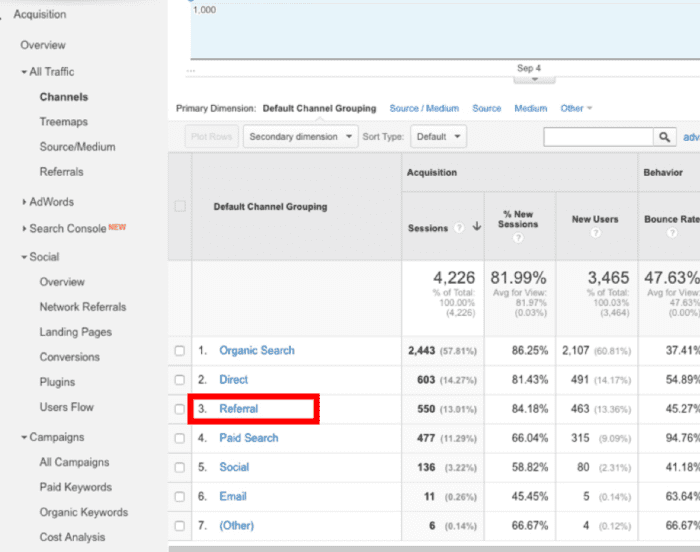
From these results, how do you calculate ROI?
Create goals in Google Analytics
If you’re running a brand awareness campaign on another website, you can track the referral traffic that comes through this campaign. If your goal is lead acquisition, then you can create a goal in Google Analytics to track leads you acquire through this traffic source.
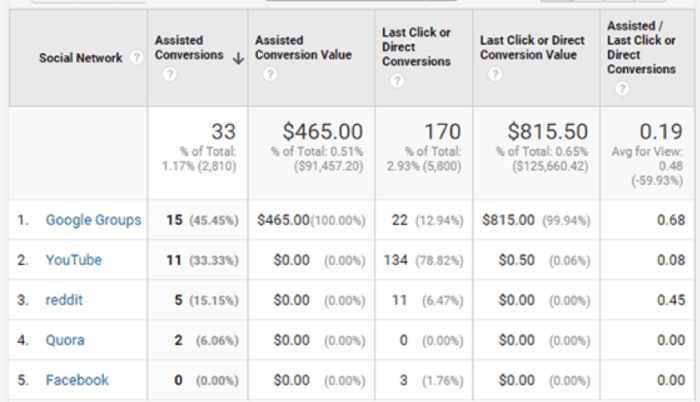
If you’re running the campaign on social media, then you can also track referral traffic that comes from social media channels involved during this campaign.
Use social attribution
Not every engaged individual will visit your website during a social media brand awareness campaign. That doesn’t make your campaign ineffective. Since the aim was brand awareness, people can be aware of your brand without visiting your website.
However, 44% of CMOs say they have been unable to measure the impact of social media on their business and marketers say their number 1 social media challenge is measuring ROI.
You can use a tool like TrackMaven that can account for the value of your social media engagement. Through this, you’re able to calculate your ROI more effectively.
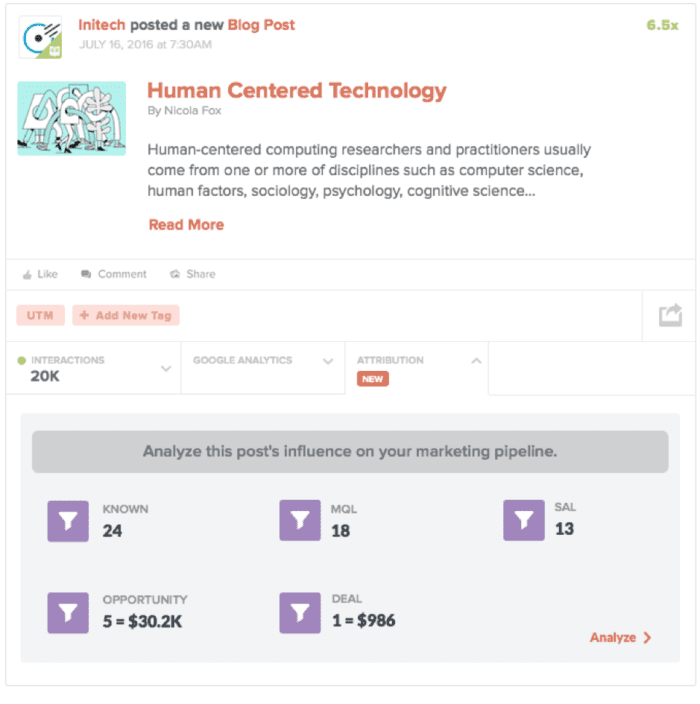
Influencer campaigns
Over the years, some people have built a reputation online. Some people who follow them trust them and the recommendations they make online. Businesses can attract many customers when influencers endorse their product or service. In most cases, this is done on social media (especially Instagram).
Businesses use two types of influencers:
- Macro influencers
- Micro influencers
Whatever the type you use for your business, how can you calculate their contribution to your bottom line?
First of all, you have to consider the possible results you can get from influencer marketing. Some of these results are:
- Reach
- Engagement
- Impressions
- Conversions
How do you convert these metrics to ROI?
If your goal is to reach more of your potential customers, then reach is an important metric. However, you need to note that reach can be as valuable as the influencer promoting your company. If the influencer is an industry expert, then their low reach could bring better conversions than a celebrity.
Engagement is usually a more valuable metric than reach. These are the number of likes, shares, and comments that a promoted post attracts. For instance, in an influencer marketing campaign, Gloria Ferrer got 2,300 clicks to their photo contest.

You can use a tool like Grin that assigns value to your engagement metrics. This way, it’s easier to calculate the ROI of your campaign.
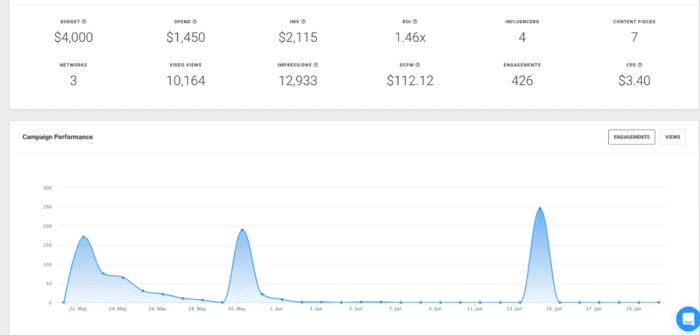
Impressions are more important than reach because this is the number of times people see your content. Conversions are the most important metric if you want to calculate your marketing’s ROI.
However, conversions for your campaign depends on how you define it. To some, it could be website traffic. It could also be the number of leads captured or customers gained.
From your value of a conversion, you can calculate your ROI based on the number of conversions.
Set objectives and achieve your marketing goals
Use the RACE Framework to achieve your marketing goals. Our popular marketing planning structure empowers marketers and managers to plan, measure, and optimize their marketing strategies using customer insights and data.
Identify opportunities for your marketing strategy integrated across the customer journey of reach, act, convert, and engage. Book your free no-obligation 1-2-1 consultation call with the customer team today to discuss marketing solutions to optimize your marketing activities and achieve your goals.
Marketing ROI next steps
When carrying out marketing campaigns that you can’t accurately measure results, then you’ll have to define your goals clearly. After doing this, you have to assign a value to what it means to achieve your goals.
With this, you can calculate your marketing ROI based on the cost of your campaign and how well you achieve your goals.


